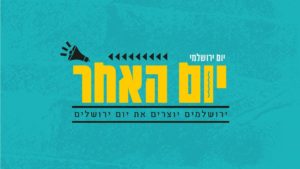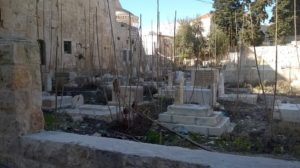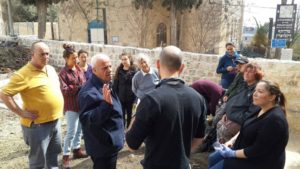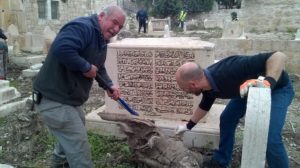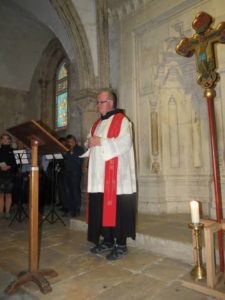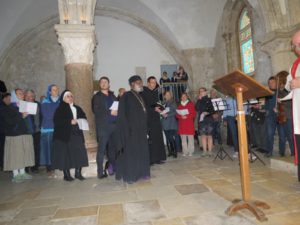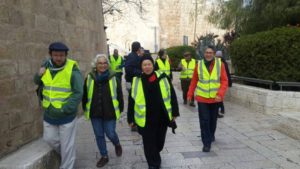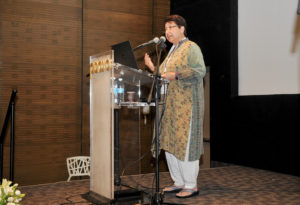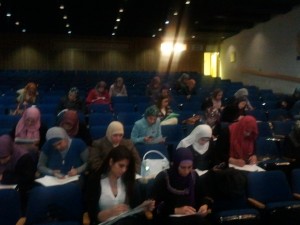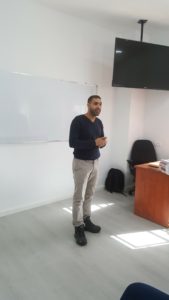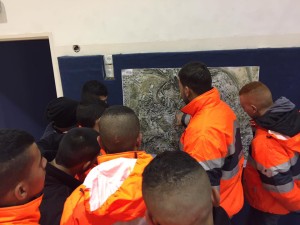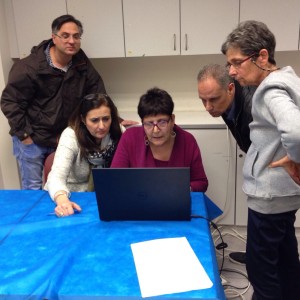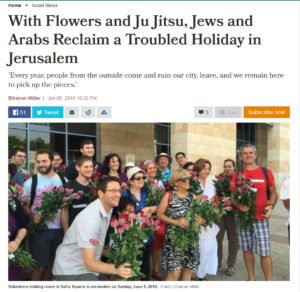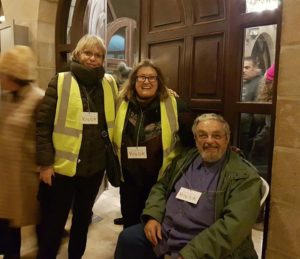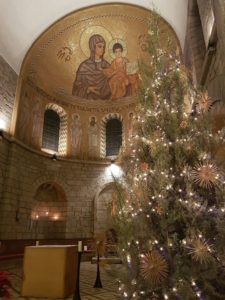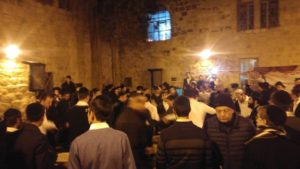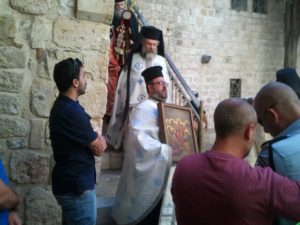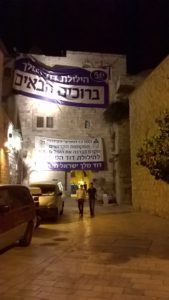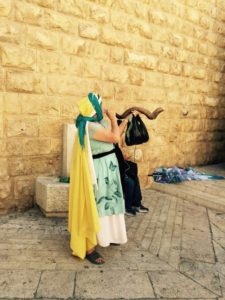Gearing Up for Jerusalemite Day
What is your Jerusalem? Who is your Jerusalemite?
This year May 23 and 24 are the days to think about Jerusalem and connect to it. This year, there are dozens and dozens of ways to do it.
Building on last year’s success of A Different Day in Jerusalem, this year we call it: Jerusalemite Day: A Day of the Other.
How do you want to connect to Jerusalem and its diversity? With tours of the Jewish-Arab seam line, the secular – Haredi seam line? Or Mount Zion, the only site that is holy to Jews, Muslims and Christians? Or Jerusalem according to asylum seekers? Commemorating those who perished in the treacherous journey from Ethiopia to Israel? Along the Jerusalem Railway Park or on the Light Rail? At a Kurdish hafla in the Katamonim or a parade on Azza St.?
Right now we have a list of some 70 events. And the list keeps getting longer and longer and longer. See here for the event on Facebook and here for the web site, which is constantly being updated.
Many thanks to the UJA-Federation of New York and the Jerusalem Foundation for their support of this program!
And here’s the entire list, updated as of 21.5.17. You can download an English list of events in PDF here:
Tuesday, May 23
15:30 – Hapoel Katamon Neighborhood League – Year-End Girls Soccer tournament that will include 12 girls soccer teams in grades 4 – 6 from throughout Jerusalem including all sectors – religious, secular, Arab. At the Keshet Sports Field.
15:30 – From Zion Square to Sallah a-Din – A Walking Tour of Jerusalem’s Urban Centers.’ A tour that examines connecting and conflict points between the Israeli and Palestinian centers of life in Jerusalem, guided by Eran Tzidkiyahu. Organized by the Ir Amim organization.
16:00 – Weaving – Macrame Workshop with Yaffi Ronen. At the Reading Station, Masryk St.
16:00 Jerusalem: An Ethnic Mosaic: Secular, Religious, Ultra-Orthodox, Arab. Presented by 4 female citizens of the city. Moderated by Daniel Goldman, Chairman of Gesher. Jerusalem Ramada Hotel.
17:00 – Tour of the Interfaith Music Conservatory with Father Alberto. We’ll meet at Damascus Gate and walk together to the conservatory that is within the St. Saviour monastery, which is adjacent to the New Gate of the Old City of Jerusalem.
17:45 Weaving – Macrame Workshop with Yaffi Ronen. At the Reading Station in Mekor Haim.
18:00 – 20:00 – Wandering around the House – A short play in which a Palestinian man and an Israeli woman choose to take an open place and claim it as their house. Come discover what happens afterwards, in a show that expresses the power dynamics of nationality and gender. This event is in English.
18:00 – Curator’s tour of a special exhibit at the Museum on the Seam. The exhibit seeks to examine secular Jewish artists and the influence of Jewish values on them and their art, at the same time looking outward at a new phenomenon of religious artists who draw inspiration from their beliefs and who engage it in a complex dialogue. The exhibit examines the connection between art and faith, both of which deal with the human acknowledgement of the revelation and the need to express it. Cost of the tour: 20 NIS. Pre-registration required.
19:00 – Bat Hur – voices and shadows echo the story of a daughter and mother who were trapped between the walls of Beit Hanson, Jerusalem’s leper colony. Two languages, two actresses, a choir and hidden Jerusalem history. Performance will take place at the Alliance Building.
19:00 – Screening of , “Turn Left at the End of the World,” organized by the Jerusalem Branch of Enosh, the Israeli Mental Health Association. The screening will be followed by a discussion about Jerusalem and welcoming the other. Discussion in Hebrew and English. Shalom Yehuda 29. This event will be held in English and in Hebrew.
19:30 – Martial Arts Advancing Peace – at the El Halev Center.
19:30 – Founder of “Stories on the Way” (Sipur al Haderech), Adv. David (Darsali) Avetta in an intimate discussion about his immigration to Israel, on ‘Yerusalem’ and about the story that an entire community is beginning to tell today. In cooperation with the Israel Association of Community Centers. We’ll meet in Diana Lipton’s house.
19:30 – The Mount Will Answer the Judgment: on Holiness and Sovereignty – The Forum for Regional Thinking invites you to the Researchers’ Community Lounge at the Alliance Building with 2 Jerusalem researchers-Tomer Persiko and Eran Tzidkiyahu, commemorating the 50th Jerusalem Day. We will discuss different perspectives, complimentary and opposing, from which we can look out on the Temple Mount / Al Aqsa.
20:00 – Ask for the Heart of Jerusalem, organized by Out for Change. In honor of Jerusalem Day, Out for Change will bring together two sectors that are intertwined with each other: Haredim and those who were formerly Haredi. We will try to bridge the gaps via a mind that seeks to know and a heart that seeks to listen. The interviewer: Pini Via, who grew up and was raised Haredi, and Mr. Benahu Tevila, a graduate of rabbinic and halakhic law studies, M.A. in Philosophy, Ministry of Education Supervisor for Haredi secondary schools, and an activist in Haredi society.
20:00 – Souls (Nefashot) – Coping through Art. A special evening in which we’ll try to bridge the gap between the headlines and the stigmas about people with emotional disabilities and their abilities. A variety of performances will tell us about their experiences in special ways: original music, spoken word, stand-up comedy, open galleries, and more. At the Abraham Hostel.
20:00 – Heroes: Dance performance -Israel, Jerusalem and the ‘Others’ within It: Because Israeli-ness isn’t a melting pot – it is the Land of Israel in all its glory, which stretches out to all those who inhabit it, to the edges that don’t connect. The performance is by the Ka’et Ensemble and will take place in the C.A.T.A.M.O.N. studio in the Alliance Building. Cost: 30 NIS
20:30 – My Heart is in the East – Jerusalem in the Eyes of North African Liturgy. Jerusalem liturgy in Hebrew, Moroccan-Arabic and Matruz, by the Paytan Maimon Meny Cohen and a musical ensemble. Organized by Kehillot Sharot.
21:00 – Visions of the Gazan youth – An unofficial meeting with Sami, a freelance journalist and peace activist from Gaza. Join a discussion about the possibility for a better future and the missing dialogue between Israelis and Gazans. This event is in English.
21:00 – Holiness and Politics: Jerusalem of Three Religions – A panel by the Rossing Center for Education and Dialogue (Formerly JCRC) invites us to a workshop in which we’ll examine the character of none other than King David, who appears in holy writings of the three monotheistic religions. Through him, and through the Jerusalem sites that are associated with him (David’s Tomb, for example), we’ll learn about the holiness of Jerusalem in Christianity, Islam and Judaism, and we’ll attempt to understand the political connections behind that holiness.
21:00 – Bat Hur – voices and shadows echo the story of a daughter and mother who were trapped between the walls of Beit Hanson, Jerusalem’s leper colony. Two languages, two actresses, a choir and hidden Jerusalem history. Performance will take place at the Alliance Building.
21:00 – 02:00 – Ma’aleh Movie Marathon. Ma’ale School of Television, Film & the Arts invites the general public to enjoy a nighttime marathon of the best new graduate movies that are participating in film festival around Israel and the world. The marathon will include films that deal with and take place in Jerusalem, covering the entire spectrum of lifestyles. The movies will be screened throughout the school. Come to a virtual-cinematic tour of the Haredi neighborhood and synagogue communities, through the crowded streets of Nahlaot, the city center, and Talpiot, to the mysterious, hidden monasteries. 20 Shivtei Yisrael St.
Wednesday, May 24
8:00 – Tour of the Rahel Checkpoint – That’s How We Do Zionism, Tolerance and Human Rights – a special tour of the Rahel Checkpoint that connects between Bethlehem and Jerusalem, by the Blue&White Human Rights group. This is a rare opportunity to hear and see up close the reality at the checkpoints, to meet the people from the field and to discover how to combine Zionism and human rights. The tour is free but pre-registration is required.
9:00 – Status Quo in Jerusalem – Tour of Mount Zion – between holy sites, forgotten stories and a delicate status quo, monks, yeshiva students, artists and business owners live side by side. Let’s get to know the viewpoints of the residents and the visitors of Mount Zion, about the shared living there and about the delicate and fascinating cooperation that takes place today. During the tour we will meet with the deputy director of the Diaspora Yeshiva Ely Dan, and Father Daniel, a monk from the Dormition community. The tour is free but pre-registration is required.
9:00 – Jerusalem is Tiptoeing In – The Djanogly Visual Arts Centre is hosting the Max Rayne Hand in Hand School for Bilingual Education and invites the general public to take part in a unique event that is completely Jerusalemite art – a rich collection of works that weaves the new-old narrative of Jerusalem from its artists’ point of view. Moving through the space we will discover new corners and faces of Jerusalem. We will examine how tensions, feelings and people build yet another story of Jerusalem.
10:00 – Heterotopia in Musrara – Tour of the Art Trail (for men), of the Studio of Her Own project. Art in the public space in northern Musrara, the third wall. Two tours, one for men (at 10:00) and one for women (11:00), guided by Rabbi Aharon Kedem from the Breslev Hassidim, and Tzipi Mizrachi from the Studio of Her Own.
10:00 – Stories on the Way at the Sieff & Marks Community Center in Beit HaKerem. The group of volunteers of the Shalem Movement will meet with Eitan Penethon for an open discussion about the story of Israelis of Ethiopian descent, on ‘Yerusalem’, and on the possibility to create change in Israeli society.
10:00 – Stories on the Way Discussion Circles – The story of the Ethiopian-Israeli Aliyah, by the Olim themselves. The discussion circles will take place at Mount Herzl, right before the official ceremony that will take place at 11:00.
10:30 – I Saw a City: Jerusalem between Dream and Reality – Tour about Jerusalem in the National Library: We will meet original objects from the Six Day War, we will view the largest stained glass window in Israel, we will become acquainted with the ancient map collection of Jerusalem and we will visit the exhibit, “City of Dreams: Jerusalem from the Imagination’s View,” Jerusalem as seen in the imaginations of Jewish, Muslim and Christian artists.
11:00 – Heterotopia in Musrara – Tour of the Art Trail (for women), of the Studio of Her Own project. Art in the public space in northern Musrara, the third wall. Two tours, one for men (at 10:00) and one for women (11:00), guided by Rabbi Aharon Kedem from the Breslev Hassidim, and Tzipi Mizrachi from the Studio of Her Own.
11:00 – Official ceremony for Ethiopian Jews who perished in Sudan. The public is invited to become acquainted with a different story that is commemorated on Jerusalem Day. The ceremony will take place at Mount Herzl. There will be discussion circles, operated by Stories on the Way, on the immigration stories of Ethiopian Jews.
11:30 A special workshop on the secrets of mediation and self-defense. Participants will learn how to correctly handle any conflict through a proper balance of wisdom and listening and action. Operated by the Mosaica Center for Conflict Resolution and The Jerusalem School of Traditional JuJitsu and Self Defense.
12:00 – 16:00 – Tolerance Stop on the light rail line, operated by the Ruach Nachon pre-army preparatory program, in cooperation with the Citypass company that operates the light rail and the Jerusalem Municipality. The stop seeks to create a Jerusalem mosaic and increase tolerance at the Municipality light rail stop.
12:30 I Saw a City: Jerusalem between Dream and Reality – Tour about Jerusalem in the National Library: We will meet original objects from the Six Day War, we will view the largest stained glass window in Israel, we will become acquainted with the ancient map collection of Jerusalem and we will visit the exhibit, “City of Dreams: Jerusalem from the Imagination’s View,” Jerusalem as seen in the imaginations of Jewish, Muslim and Christian artists.
15:00 – Wall art for girls in the Art Shelter studio in the Mekor Baruch neighborhood, together with Solomon, the fantastic graffiti artist! Children (and adults) welcome.
15:30 – 18:30 – The Jerusalem March along the Jerusalem Railway Park, by the Yerushalmim Movement. Jerusalem communities march together and celebrate Jerusalem’s diversity. There will be 3 starting points:
15:30 – Beneath the Baram Bridge, the long route
16:00 – Gonenim Park, the general route
17:15 – Oranim Junction, the Family March
18:15 – Festive event at the First Station.
The march will be accompanied by Marsh Dondurma, Tahrir Eastern Bar and Kehillat Zion. Activities for children, music, balloons and a range of surprises will be distributed along the route!
16:00 – 21:00 Building Our Own Jerusalem with Lego – A building site for Jerusalemites from all ethnicities, religions and opinions. Building together a tolerant and inclusive Jerusalem from tens of thousands of Lego pieces. At the Davidka Light Rail Station. No Hebrew required.
16:00 – Street Beit Midrash on the Ben Yehudah Midrachov. A special session about tolerance and Jerusalem.
16:00 – Ascension Ceremony at the Church of the Ascension on the Mount of Olives. At 16:00 all the Christian churches will begin their ceremonies. At 16:45 the Catholic Franciscan evening service will begin. It is a Christian ceremony, please come dressed appropriately.
16:00 – Traditional Flower Parade organized by Tag Meir: Light instead of Terror. Let’s distribute flowers to the residents of the Old City.
16:00 – 23:00 – Katatmon’s Wisdom: Katamon Culture in Houses and in the Streets. An entire festival of Katamon-led activity, including neighborhood tolerance activities:
16:30 – 18:00 – “Here There Was…” a tour of the Katamonim neighborhood from the outlook of 3 women from different ethnic backgrounds. Starting from the gat of the Gonenim Park.
17:00 – Writing Workshop: Poetry from Recipes. Recipes from different ethnic groups are written as new Israeli poetry. The workshop will take place at the reading station on the Jerusalem Railway Park.
17:00 – The Parliament. Neighborhood residents from all cultures and ages are invited to the Butka Café to hold a neighborhood parliament, in which we talk about everything.
17:00 – 19:00 – Katamon Portrait. Neighborhood residents take pictures of themselves next to the Well-Baby Clinic.
17:30 – 19:30 – A Knit – A Space for Knitting. A simple space for knitting and learning how to knit, regardless of religion, creed or gender.
18:00 – Ethnic cooking workshops in residents’ homes. Learning about the dish as well as how to prepare Ingra with Abbebe and Kubbeh with Hannah.
18:00 – Kurdish Hafla – A Kurdish dance party with food.
18:00 – Meeting at the Beit Midrash – Asking for Peace of Jerusalem. The Matan women’s Beit Midrash opens its doors for joint learning for women from all backgrounds.
18:15 – Women’s Song: Vocal Creations as an Agent of Change. Vocal artist Faye Shapiro will tell about the “Rivers of Katamonim” project that she led with older women, together with young artists. It will meet at the Gonenim Community Center, and include vocal work and singing.
19:00 – Ethiopian Celebration – songs, dances, food, in the plaza in front of the minimarket on San Martin St.
19:30 – Choosing to Feel Well. Loneliness is a cross-cultural experience. We will hear about Alan’s project, which creates an inviting space for everyone to deal with loneliness together.
19:30 – Singing together songs from Israel and different ethnic groups. Organized by the Singing in the Garden initiative, in San Simon Park.
19:30 – 21:00 – Katamon Portrait 2 – Taking pictures of ourselves in San Simon.
17:00 – Wall art for boys in the Art Shelter studio in the Mekor Baruch neighborhood, together with Solomon, the fantastic graffiti artist! Children (and adults) welcome.
17:00 – 50 Years, 50 Faces – An opening festive event marking the documentary project of the Tower of David Museum of the History of Jerusalem, commemorating 50 years since the reunification of Jerusalem, presenting 50 personal stories of Jerusalem residents from all its corners, from the time directly after the 1967 war. It will include video clips, interviews, text and original pictures.
17:00 – Everything Private: Prayers, Stories and Staged Reading of ‘Everything Private’. A play based on meeting minutes of the Barashi synagogue’s board in Nahlaot. The minutes combine the holy with the everyday, and touch on practical details from the everyday life of the synagogue and community. It is spiced with light irony, and sometimes self-humor, yet it preserves the accuracy, honor and the reality of the time. The play has a contemporary and universal message about the unique drama and meaning of worlds that are disappearing, worlds that are being built, and colorful characters that are building them; and on longing and love. At the Museum of Italian Jewry.
17:30 – Black and White Jerusalem – A tour on the seam line between Haredi and non-Haredi neighborhoods to understand the Haredi sector, organized by the Tarbuth organization. We’ll meet in Davidka Square.
18:00 – Jerusalem for All Festival – with performances by Echo, Tito and Jaluk. There will be a stage for Jerusalemite performers. Kelly Halperin and Moshe Waldman will hold a panel on Jerusalem entrepreneurship. There will be stands selling art, art installations and a poetry slam and of course food and drink. The even strives to bring together different groups in the city, emphasizing the human and cultural diversity in Jerusalem. At the Alliance Building.
18:00 – Tour of Jerusalem as a City of Asylum: Jerusalem in the Eyes of the Asylum Seekers who Live There. A tour by the Jerusalem African Community Center.
18:45 – Believers – An evening of inter-religious prayer and listening circles, on listening and the Holy City, with Kehillat Zion, Marsh Dondurma, Tahrir Eastern Bar and the Yerushalmim Movement, and Arab and secular and Haredi Jewish leaders.
19:00 – New Haredim, the Formerly Religious, and All that Cholent. Journalist Mendy Grosman hosts Moshe Sheinfeld and Avi Tapilinsky at the Tmol Shilshom Café.
19:30 – Shfuyah B’Haloma (Sane in Her Dream) – A multi-aged, multicultural Jerusalemite panel on the occasion of the launch of Dr. Elan Ezrachi’s new book, Shfuyah B’Haloma. The panel will include: Ora Ahimeir, Keren Brunwasser, Eran Tzidkiyahu, Yossi Klein-Halevi.
19:30 – Screening of the movie, “The Seventh Day,” and discussion with Suleiman Hattib, founder of Combatants for Peace. Afterward we’ll dive into the sounds of Fuad Abi A-Nam and Friends.
19:30 – Meeting of Stories on the Way with Daressa Atchnepa – his emotional story of immigrating to Israel from Ethiopian. In the home of the Dahan family.
20:00 – Storytellers Evening on Jerusalem and Tolerance at the BeShutaf Cooperative. During the evening Jerusalemites will tell their stories: some sad, some happy, some emotional, some will leave you stunned. But all are real. Facilitated by Itamar Farhi.
20:30 – Beyond the Dark Mountains – a journey near home. We will commemorate 50 years since the Six Day War, which are also 50 years of shared living between Jerusalem residents from eastern and western parts of the city. Eliezer Ya’ari will take us on a journey to the people who live in East Jerusalem, part of the capital of Israel, and will enlighten us about their thoughts and dreams, on shared living in the city, on the daily reality, and on the future. We will meet at the Jerusalem Cinematheque.
21:00 – Jibberishalem – Improvising the language, by JLMprov. An interactive improvisational performance on Jerusalem and its characters. We will meet in Alliance Building. No Hebrew required.
21:00 – Bat Hur. Voices and shadows echo the story of a daughter and mother who were trapped between the walls of Beit Hanson, Jerusalem’s leper colony. Two languages, two actresses, a choir and hidden Jerusalem history. Performance will take place in the Alliance Building.
21:00 – Yachas Ham at Birman. A special performance of the Yachas Ham band, paying tribute to Bob Dylan’s birthday (and Shakespeare’s). Let’s hear about tolerance as expressed in Bob Dylan’s songs.
All Day – Teachers Lounge project of “This is Jerusalem.” An exhibition of a year-long program that brought together Jewish and Arab educators. The exhibition will be shown at the First Station.
All Day – Jerusalem Tolerance Cookie Decorating! International competition of cookie artists who decorated cookies to emphasize tolerance in Jerusalem. Organized by Jerusalem Cake Design.
Events Not Open to the General Public
Special activities to advance tolerance at the Dror High School (religious).
Students from the Tag Meir student organization light up Jerusalem – Students will visit high schools throughout Jerusalem and will operate workshops on tolerance in Jerusalem.
The Scouts – all participants in the scouts will have special activities for Jerusalem Day, focusing on Jerusalem, its complexity, its uniqueness and its place in Israeli society.
Workshop by the Center for Middle Eastern Music for students for the Keshet School.
An Accessible City: Photography exhibit. The school at the ALYN Rehabilitative Hospital will hold a party celebrating Jerusalem’s many cultures. The program: An Accessible City – a photography exhibit. Songs about Jerusalem in Hebrew and Arabic and a competition identifying places in Jerusalem. The workshop is closed to the public but the exhibit will be open.
Meeting for all group coordinators from the Interfaith Encounter Association to meet each other.

